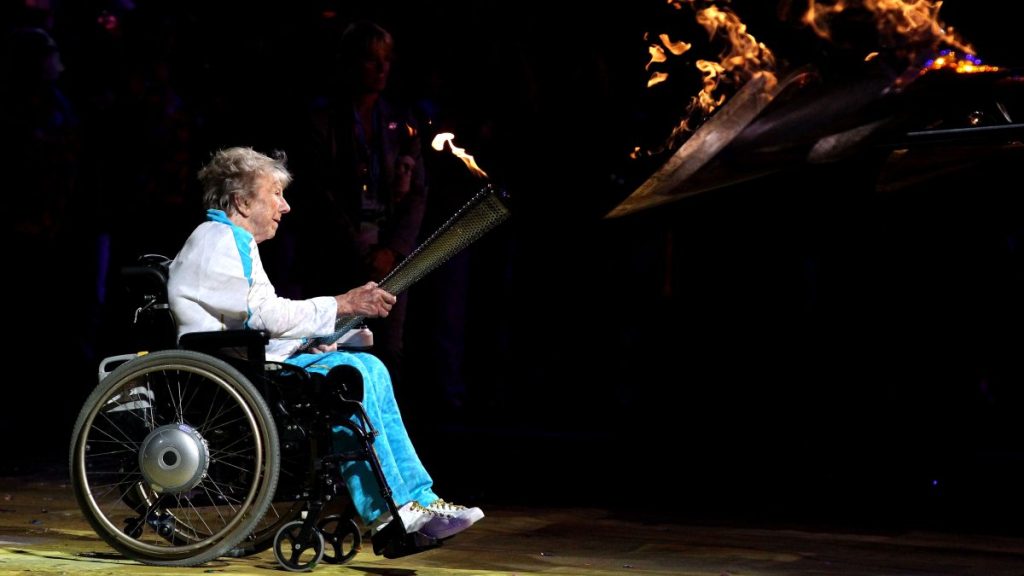Two weeks after French star swimmer Léon Marchand extinguished the Olympic flame to close the Paris Olympics, the spotlight is now on its Paralympic counterpart.
The flame will be lit on Saturday in Stoke Mandeville, a village northwest of London widely considered the birthplace of the Paralympic Games. The flame will then travel to France under the English Channel for a four-day relay from Atlantic Ocean shores to Mediterranean beaches, from mountains in the Pyrenees to the Alps.
Its journey will end in Paris on Wednesday during the Paralympics opening ceremony — with the lighting of a unique Olympic cauldron attached to a hot-air balloon that will fly over the French capital every evening during 11 days of competition.
The Flame is Lit
The lighting ceremony of the Paralympic Heritage Flame on Saturday will be held in Buckinghamshire, where the Stoke Mandeville Games were first held in 1948 for a small group of wheelchair athletes who had sustained spinal injuries during World War II.
The man behind the idea was Ludwig Guttmann, a Jewish neurosurgeon who fled Nazi Germany and worked at Britain’s Stoke Mandeville hospital. At the time, suffering a spinal injury was considered a death sentence, and patients were discouraged from moving. Guttmann made the patients sit up and work muscles, and hit upon competition as way to keep them motivated.
Those later grew into the first Paralympic Games, which took place in Rome in 1960. The Heritage Flame ceremony in Stoke Mandeville was first held ahead of the London Paralympics in 2012.
Crossing the Channel
The flame will then cross the sea like its Olympic twin did when it arrived in France from Greece in May — but this time via the Channel Tunnel. That marks the start of the Paralympic relay.
A group of 24 British athletes will embark on the underwater journey through the 50-kilometer long (30-mile) tunnel. Midway through, they will hand over the flame to 24 French athletes who will bring it ashore in Calais. It will be used to light 12 torches, symbolizing 11 days of competition and the opening ceremony.
Three-time Paralympic medalist Trevon Jenifer previews the wheelchair basketball competition at the 2024 Paris Paralympics. Off the court, Jenifer is the face of Citi’s “What happened” advertising campaign.
4 days, 1,000 torchbearers and 50 cities
Once on French soil, the flame’s 12 offshoots will head in different directions to kick off the Paris Olympics’ encore and aim to rekindle enthusiasm for the Games.
Among 1,000 torchbearers will be former Paralympians, young para athletes, volunteers from Paralympic federations, innovators of advanced technological support, people who dedicate their lives to others with impairments and people who work in the non-profit sector to support carers.
They will take the flame to 50 cities across the country to highlight communities that are committed to promoting inclusion in sport and building awareness of living with disabilities.
An exceptional flame will be lit in Paris on Sunday to commemorate the 80th anniversary of the liberation of the French capital from Nazi Germany occupation during World War II.
Highlighting para sport infrastructure and innovation
The relay will highlight places that are committed to developing para sports, as well as places where famous Paralympians grew up, such as Lorient, home of double Paralympic sailing gold medalist Damien Seguin. It will also stop in Blois, which has a sports complex named after its Paralympic track athlete Marie-Amélie Le Fur who has nine medals, including two golds from Rio.
The relay will go through Châlons-en-Champagne, which has the only gymnasium in France designed to facilitate access to sport for people with intellectual disabilities. And Rouen, Chartres, and Troyes, which offer a range of disciplines, from sledge hockey to para tennis, para triathlon, adapted baseball and para climbing.
The flame will stop in Chambly, which, with its three sports facilities adapted for para sports, has served as a training camp location alongside Deauville and Antibes.
Meet the star of the Games – the cauldron
On Wednesday, the 12 flames will become one again when the relay ends in central Paris after visiting historical sites along the city’s famed boulevards and plazas before lightening the cauldron during the three-hour opening show.
The cauldron is the first in Olympic history to light up without the use of fossil fuels. It uses water and electric light and is attached to a balloon. It made a stunning first flight at the Olympics opening ceremony.
Each day of the Paralympics, the cauldron will fly more than 60 meters (197 feet) above the Tuileries gardens from sunset until 2 a.m.
Sarah Adam, who was diagnosed with multiple sclerosis, is attempting to become the first woman to ever represent Team USA at a Paralympics in wheelchair rugby, a sport so violent it is nicknamed “murderball.”

